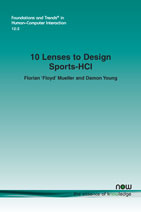10 Lenses to Design Sports-HCI
By Florian Mueller, Exertion Games Lab, RMIT University, Australia, floyd@exertiongameslab.org | Damon Young, Exertion Games Lab, RMIT University, Australia, damon@exertiongameslab.org
Abstract
Interaction designers are increasingly interested in the physically active human being. However, recent work suggests that HCI is still at an early stage when it comes to supporting the many virtues of engaging in sports. To advance this, we present a set of 10 lenses based on virtues aligned with sports activities to help designers to see physical activity not just as a way to prolong life, but as opportunity for personal growth. The Sports-HCI lenses facilitate learning how to appreciate a void (Reverie), finding pleasure in exertion (Pleasure), become humble (Humility), enjoy the stimulation that comes from fear (Sublime), be more aware of one’s own body (Oneness), value sacrifice as a chance for a simpler existence (Sacrifice), bring beauty into the world through movement (Beauty), see benefit in pain (Pain), foster consistency for life (Consistency) and welcome patience (Perseverance). We examined related work and reflected on our own craft knowledge in order to articulate what opportunities interactive technology offers to every lens. With this, we aim to support interaction designers in facilitating the many virtues of being physically active.
10 Lenses to Design Sports-HCI
In recent years, the increased availability and reduced cost of sensor systems have led to a plethora of wearables such as smart sport watches that can track exertion activities. Sensors are now also embedded in sports clothing and game console accessories to monitor activity or stimulate gaming. Technical advancements like these have led to an increased interest into exertion experiences by the research community, resulting in the term Sports-HCI.
Often, human-computer interaction around exercise and health make the underlying assumption that the human body can be seen as a machine, only monitoring measurable parameters, neglecting more human factors that help users to learn something about themselves, who they want to become and how to get there, through exertion experiences. This monograph uses the focussed technique of lenses to highlight factors that interactive technology could deploy to provide powerful opportunities in the design of such systems. Designers of interactive systems for exertion experiences can use the 10 lenses included in this monograph to explore the theoretical discussion around stimulating users through the use of technology. Each lens is unpacked into three components that provide designers with practical handles so they can engage with them in their design practice. This is complemented with design examples to suggest how such thinking can lead to particular designs.
10 Lenses to Design Sports-HCI is a stimulating read for all designers of computing systems that include an aspect exertion experiences. Students and researchers will find a wealth of new areas for further research contained within.
